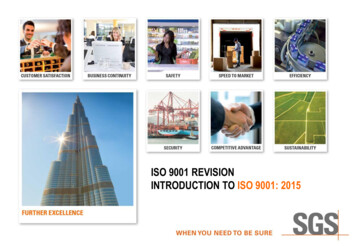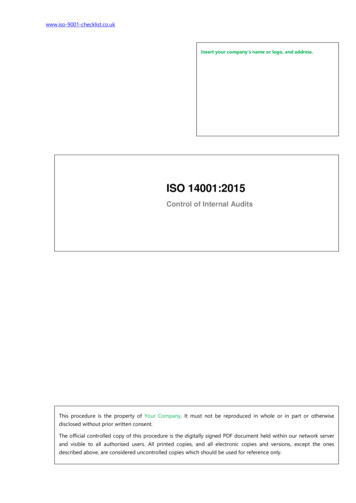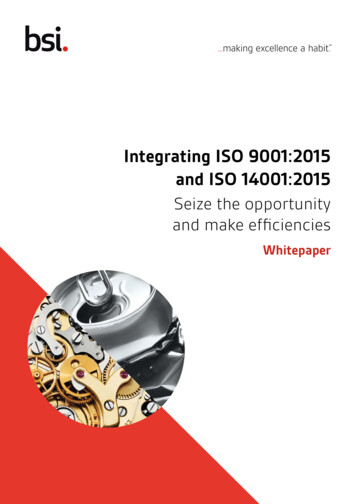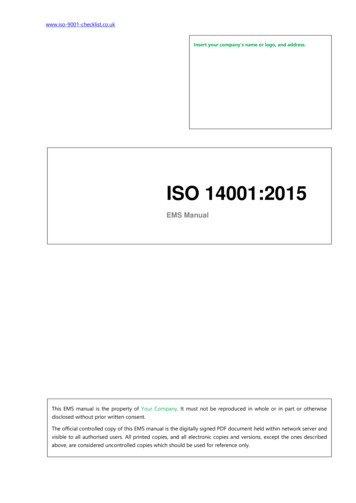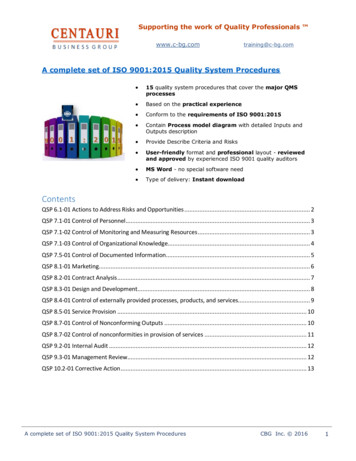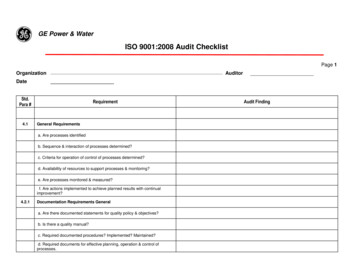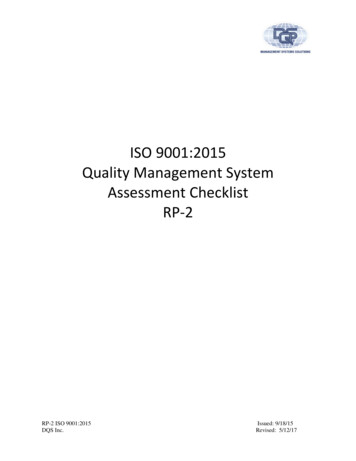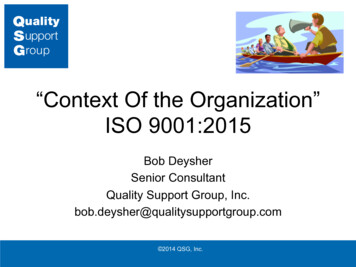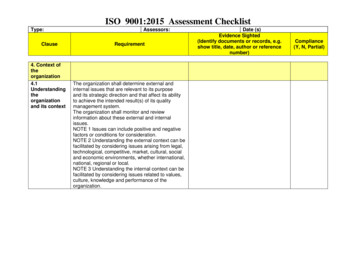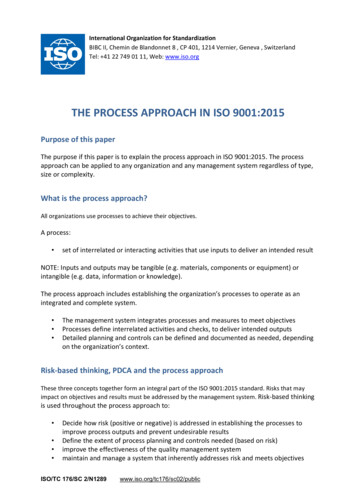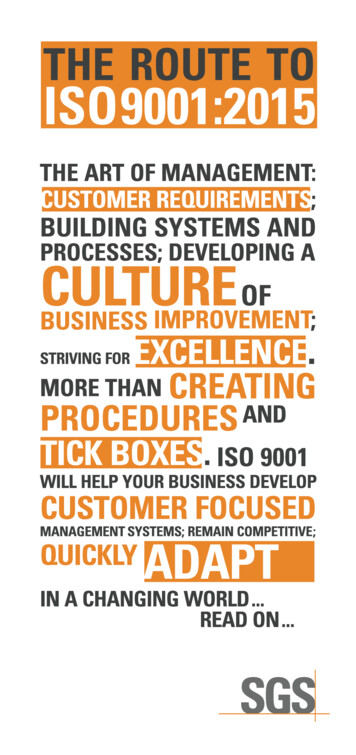
Transcription
THE ROUTE TOISO 9001:2015
FOREWORDThe purpose of this booklet is to provide a simple introductionto ISO 9001 Quality Management Systems. It is notintended to be a full explanation of the standard nor of itsimplementation, rather, it aims to promote understanding andto help the reader profit from the experience of third-partyauditors, and the problems encountered by others.It is hoped that this simple approach will cut throughsome of the ‘fog’ and ‘management speak’ that so oftenovercomplicates something that should be reasonablystraightforward.It is not intended as a replacement for the standard, and thereader is strongly advised to purchase a copy of ISO 9001 ifplanning to implement an ISO 9001 quality management system.A copy of the standard may be purchased at www.iso.organd will also be available from the reader’s National Standardspublishing authority.Some of the wording of this booklet is taken from ISO 9001and SGS acknowledges the permission of the British StandardsInstitute for use of those extracts. Copyright SGS United Kingdom Ltd 2016All rights reserved. No part of this publication may be copied, reproducedor transmitted in any form by any means without the written permission ofSGS United Kingdom Ltd.
THE ROUTE TO ISO 9001:2015CONTENTSPage NumberTERMS And DEFINITIONS4INTRODUCTION TO ISO 9001:201554.1Understanding the organisation and its context94.2Understanding the needs and expectations of11interested parties4.3Determining the scope of the quality management 12system4.4 Quality management system and its processes145.1 Leadership and commitment155.2Policy185.3Organisational roles, responsibilities20and authorities6.1 Actions to address risk and opportunities216.2 Quality objectives and planning to achieve them236.3Planning of changes247.1Resources257.2Competence287.3 Awareness297.4Communication307.5Documented information308.1Operational planning and control338.2Requirements for products and services348.3Design and development of products and services 368.4Control of externally provided processes,40products and services8.5Production and service provision438.6Release of products and services478.7Control of nonconforming outputs479.1 Monitoring, measurement, analysisand evaluation-3-49
THE ROUTE TO ISO 9001:20159.2Internal audit519.3 Management review5210.1 General (improvement)5410.2Nonconformity and corrective action5410.3Continual improvement56THE CERTIFICATION PROCESS56SGS Training58SGS IN THE UK58TERMS and DEFINITIONSAll terms and definitions given in the text of the booklet can befound in the reference document:ISO 9000:2015 Quality Management Systems – Fundamentalsand Vocabulary-4-
THE ROUTE TO ISO 9001:2015INTRODUCTION TO ISO 9001:2015This booklet gives a brief introduction to ISO 9001 and points outsome of the common pitfalls in implementation and preparing forthird-party audit.For an organisation the adoption of a quality management system isa strategic decision, made to improve its overall performance and toprovide a solid basis for sustainable development initiatives.Consistently being required to meet and address future needsand expectations can pose a challenge for organisations in anenvironment that is increasingly dynamic and complex.The international standard ISO 9001 promotes the adoption of aprocess approach when planning, developing, implementing andimproving the effectiveness of its processes and their interactionswith an aim to enhance customer satisfaction by meeting customerrequirements.This international standard can be applied to any type or size oforganisation.Risk-based thinking has been introduced into the InternationalStandard, which has enabled a reduction in prescriptiverequirements, being replaced by performance based requirements.The incorporation of the PDCA cycle ofPLAN è DO è CHECK è ACT has been retained.As one of the key purposes of a quality management system isto act as a preventive tool the need to have a separate clause onpreventive action has been removed.Throughout this booklet the following verbal forms are used:‘shall’ indicates a requirement‘should’ indicates a recommendation‘may’ indicates a permission‘can’ indicates a possibility or a capability.The ‘PLAN’ part of the process starts by establishing the objectives,looking at risks and opportunities and any associated actions, andplanning any changes necessary to deliver results in accordance withcustomer requirements and the organisation’s policies.-5-
THE ROUTE TO ISO 9001:2015Actions to address risks and opportunities6.1*Quality objectives and planning toachieve them – 6.2*Planning of changes6.3** clause of ISO 9001:2015The organisation will also have to take into account the context oftheir organisation, the needs and expectations of their interestedparties (including all statutory and regulatory requirements thatare applicable to the product, service or application to ensure itssafe and proper intended use to the customer or end user) andany changes that are required to their quality management system.Therefore the interested parties will play a significant role in definingthe requirements as inputs into the ‘PLAN’ part of the process.Now comes the ‘DO’ part of the implementation cycle. The objectivesand processes now established have to be implemented and managed.* clause of ISO 9001:2015Support7.1*, 7.2*, 7.3*, 7.4*, 7.5*Operation8.1*, 8.2*, 8.3*, 8.4*, 8.5*, 8.6*, 8.7*A choice can be made on how this is achieved. Some can bemanaged through improvement programmes and be subject toObjectives, Targets and Management programmes, or they can becontrolled by operational control procedures. In some instances bothof these mechanisms can be applied.An important part of the process, the ‘CHECK’ part, comes next.This includes the monitoring and measurement and subsequentresults of the quality management system. Inputs will also comefrom customer satisfaction (interested parties) and from theproducts and services offered themselves.-6-
THE ROUTE TO ISO 9001:2015Performance evaluation9.1*, 9.2*, 9.3** clause of ISO 9001:2015This ensures that the controls and procedures are functioning asintended. There is a requirement to report all findings and results,normally through the internal audit process and at managementreview meetings.The final part of the cycle is for the organisation to ‘ACT’ against thefindings and results, which may be through nonconformity and/orcorrective action.* clause of ISO 9001:2015Improvement10.1*, 10.2*, 10.3*There will be a requirement to take action to continually improveprocess performance.The PLAN è DO è CHECK è ACT methodology is designed tooperate at all levels through the organisation and can be applied toall processes.Underpinning the four elements of the PDCA is clause 5 of theInternational Standard – Leadership (5.1*, 5.2*, 5.3*).-7-
THE ROUTE TO ISO 9001:2015ISO 9001 PROCESS FLOWCHARTActions to address risks andopportunities – 6.1*Quality objectives and planningto achieve them – 6.2*PLANPlanning of changes6.3*Support7.1*, 7.2*, 7.3*, 7.4*, 7.5*Operation8.1*, 8.2*, 8.3*, 8.4*, 8.5*,8.6*, 8.7*DODOPerformance evaluation9.1*, 9.2*, 9.3*Improvement10.1*, 10.2*, 10.3*ACT*clause of ISO 9001:2015ISO 9001:2015 uses the Annex SL template (framework), which is arequirement for all new and revised Management System Standards.It provides the high level structure (i.e. major clause numbers andtitles) that are fixed and cannot be changed, core text, commonterms and core definitions. Discipline-specific sub-clauses maybe added (which is the case for ISO 9001:2015). Similarly, therewill be common requirements across all the management systemstandards, for example the requirement to “.establish, implement,maintain and continually improve the management system”. One ofthe consequences of adopting the Annex SL template is that someof the requirements of ISO 9001:2008, which are unchanged in ISO9001:2015, are now located under different headings in differentnumbered clauses.Although all of the requirements in ISO 9001:2015 are intendedto be applicable to all types of organisation, of whatever size, it isrecognised that there may be circumstances where an organisationcannot comply with a specific requirement because it simply does-8-
THE ROUTE TO ISO 9001:2015not undertake a certain type of activity as part of its business. Insuch a case the organisation can regard the requirement as ‘notapplicable’. However, it cannot do this if it would affect its ability tosupply products or services that comply with client requirements, orwhich adversely affect its ability to enhance customer satisfaction.The organisation has to justify designating any elements of ISO9001:2015 as not applicable.“QUALITY AUDIT” OR “AUDIT OF QUALITY”If you simply audit a site or business, identify its quality problemsand then fix them you could well return a year later to find thatall of the problems have reappeared simply because there is nomanagement system in place.On the other hand, if you install a quality management system,make it work and then audit that system you deliver real control andgenuine ongoing improvement.An ISO 9001 QMS provides a system of inter-linking processes. It is aneffective toolkit of mechanisms for managing quality issues in any kindof organisation. It is only prescriptive in terms of what must happen,leaving the how to the organisation to decide or devise for itself.This approach means that ISO 9001 can be applied to any kind andscale of organisation. It also explains why, from time to time, thereare misunderstandings of its intent and in its application.The adoption of an ISO 9001 MANAGEMENT SYSTEM will mean that an organisation will potentially benefit from: The ability to consistently provide products and servicesthat meet customer and applicable statutory and regulatoryrequirements Facilitating opportunities to enhance customer satisfaction Addressing risk and opportunities associated with its contextand objectives The ability to demonstrate conformity to specified qualitymanagement system requirements.The notes below are preceded by the clause number of ISO 9001:2015and are presented in the order they appear in the standard.4.1 Understanding the organisation and its contextThe ‘context’ of the organisation (sometimes called its business ororganisational environment) refers to the combination of internal-9-
THE ROUTE TO ISO 9001:2015and external factors and conditions that can have an effect on anorganisation’s approach to its products, services and investments.As a result, the design and implementation of an organisation’squality management system will be influenced by its context (andany changes to it).An organisation’s context will include, for example: the specific objectives of the organisation;the needs and expectations of its customers and any otherrelevant ‘interested parties’;the products and services it provides;the complexity of both the processes that the organisationuses and the way in which they interact;its size and organisational structure.This is not a completely new concept for quality management systems,since the Introduction to ISO 9001:2008 (section 0.1 General) includesa number of references to the examples as given above.An organisation has to identify those external and internal issues thatare relevant to its ‘context’ and that can affect its ability to achievethe intended outcome(s) of its management system. The organisationmust also continue to monitor and review those issues to establishwhether any changes to them will affect its QMS, or its purpose.Although many organisations will already be monitoring internaland external issues, this is a new requirement that all clients willnow need to comply with.There is no specific requirement that these internal and externalissues, or their monitoring and review, have to be documented byan organisation. However, in many cases this information couldbe available from several different sources. It may form part of anorganisation’s documented business plan or business strategy,for example, or be referenced on the organisation’s website, inits annual reports to shareholders, or there may even be simply asection in the management review minutes dealing with this issue.Senior management will be best placed to explain the organisation’scontext since the organisation has to consider its ‘strategic direction’when identifying internal and external issues. Depending on anorganisation’s management structure, its quality manager, forexample, may not have sufficient knowledge of the issues relevant tothe organisation’s context and be unable to provide the informationnecessary to verify compliance with the requirements of this clause.- 10 -
THE ROUTE TO ISO 9001:2015This table summarises the requirements of clause 4.1.Requirements or Comment/PlanHas the organisation determined:Internal issues?External issues?Relevant to its purpose andstrategic direction Does the organisation monitor andreview: Internal issues? External issues?4.2 Understanding the needs and expectations ofinterested partiesAn organisation is required to identify the ‘interested parties’ thatare relevant to its QMS. By ‘relevant’ ISO 9001 means those partiesthat can or could have an impact on the organisation’s ability toconsistently provide products and services that meet customer andapplicable statutory and regulatory requirements. The organisation isalso required to identify what requirements these interested partiesthemselves have, which are relevant to the organisation’s QMS.Ongoing monitoring and review of these interested parties and theirrequirements is also required.An ‘interested party’ (sometimes referred to as a ‘stakeholder’) isany person or organisation that can affect, be affected by, or perceivethemselves to be affected by the decisions or activities of theorganisation implementing the QMS. These interested parties couldinclude the organisation’s shareholders, employees, customers, endusers, suppliers, regulators, pre
ISO 9001:2015 uses the Annex SL template (framework), which is a requirement for all new and revised Management System Standards. It provides the high level structure (i.e. major clause numbers and titles) that are fixed and cannot be changed, core text, common terms and core definitions. Discipline-specific sub-clauses may be added (which is the case for ISO 9001:2015). Similarly, there will .
